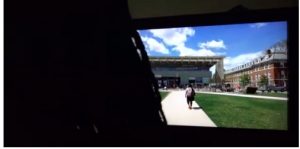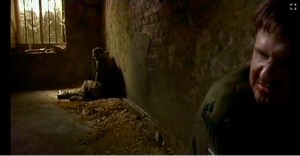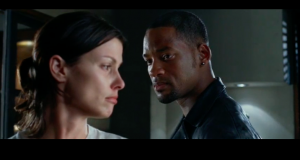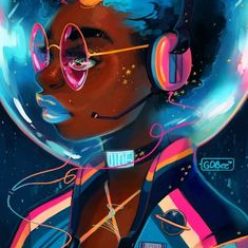Structural Analysis for Look Back When You’re Walking 👀
Part I. The Plot
Sequence 1 A young, Black woman wakes up to start her day. Through narration, we learn that her name is Jay and she is a college student who is very active on her campus.
Sequence 2 Immediately after waking up, Jay turns off her alarm and checks her phone. She scrolls through Tinder and Groupme, updating herself on what has happened overnight.
Sequence 3 After getting out of bed, Jay continues checking her social media while getting ready for her day. Leaving her room and heading to class, she listens to “Act Up” by the City Girls.
Sequence 4 After class, Jay walks to Paresky to do work. While sitting in Lee’s, her friend approaches her and shows her a meme that she has already seen. They laugh.
Sequence 5 Next, it is time for Jay to do what she does every day–surf the web.
Sequence 6 At a meeting for her group project, Jay and her friends discuss how digital technologies reinscribe and/or eliminate distinctions of race. Jay mentions how there could be a special curator deciding what we see, which we then use to learn about different races and cultures.
Sequence 7 After her meeting, Jay returns to her dorm room and gets ready for bed. As she is in bed, she scrolls through social media on her laptop one last time.
Sequence 8 While she is sleeping, the camera that has been watching her all along zooms in on her face.
Sequence 9 Next, an unknown person watches Jay’s day unfold on screen.
256
Part II. Scene Selection & Analysis (7:10)

In this frame, we see an unknown figure watching Jay as she walks from class to Paresky. The camera, while filming from behind, is shooting the scene from eye-level which allows for audience members to see exactly what the mystery man (or woman) is seeing from the same perspective. Due to the camera’s positioning, we can only see that there is a person, but we cannot tell who they are.
Right before this scene, Jay speaks to her friends as they work on a group project. They speak about whether or not digital technologies affect our understandings of race to which Jay says that they do and that there could possibly be someone watching what we do to determine what it is that we see on social media. The current scene displayed above addresses just that. The person watching Jay throughout her day could be perceived as the curator of Jay’s social media content. As he or she is watching Jay navigate the spaces of her school, they use her interactions with those around her, as well as past data from her social media activity, to craft what Jay will see the next time she is on her phone. What Jay then sees will determine how she understands the world around her, but especially race.
On the other hand, with the camera’s orientation as is, the identity of the anonymous viewer is open to interpretation and could be assumed to be a random person who is watching Jay and actively surveilling her. Considering cameras everywhere and almost all social media platforms allow us to record, the anonymous viewer could have received this footage from anywhere. While the information collected from watching Jay will not be used to construct her timeline, it encourages the viewer of our multimedia narrative to be wary of what they do and post because there is always someone watching. While this is unsettling, it reveals the dangers of today’s digital technologies.
325
Structural Analysis for 28 Days Later
Part 1:
Sequence 1: The Birth of The Infection. Animal rights activists release captive monkeys infected with rage. The infection starts to spread, thus leading to 28 days of chaos and violence.
Sequence 2: The Infection Aftermath. A hospital patient, Jim, wakes up naked and scared. He goes searching for people around London. He is chased by infected people and he is saved by Selena and Mark.
Sequence 3: The Start of Team Selena and Jim. After learning about the intensity of the infection, Jim insists on finding his family. While lighting a candle, Jim attracts the Infected to his home. Mark gets the infected blood into his bloodstream, and Selena immediately kills him.
Sequence 4: Introduction to Frank and Hannah. Selena and Jim seek refuge with a man named Frank and his daughter Hannah. They discover a recorded message over the radio about soldiers having the answer to infection. The realizes that they all need each other to survive.
Sequence 5: Journey to the Answer to the Cure. While driving through a sketchy tunnel, they get a flat tire. After they are set free, they stock up at the grocery store. They stop for gas, and Jim kills his first infected boy. Jim doesn’t tell Selena.
Sequence 6: Dreams in the Green. Jim has a bad dream that he was left alone. Selena kisses Jim. Selena apologizes and he tells her to keep his apology.
Sequence 7: The Destination of the Compound. The group makes it to the compound, and they discover that there is no one there. Frank walks about frustrated and the blood of an infected person gets into his eyes. The soldiers kill Frank, and they take the rest group to the compound.
Sequence 8: Introduction of Major Henry West and His soldiers. West gives Jim a tour of the compound, and West shows Jim the captive infected soldier. Selena wears the burden of keeping Hannah safe. Jim and Selena kiss again. West reveals to Jim that they have no cure.
Sequence 9: Dinner at the Compound. While everyone is eating, West explains that the infection is not a global epidemic. Instead, the infection is simply people killing people.
Sequence 10: It is Not What It Seems. Jim goes to West to tell him that he wants to leave the compound. West reveals to he can’t promise a future without a woman. Therefore, West decides to kill Jim and Sergeant Farrell. While captive, the Sergeant reveals to Jim that they might be quarantined. However, Jim is able to escape by blending in with the dead bodies.
Sequence 11: The Red Dresses. Selena forcibly kisses the soldier in order to allow for Selena and Hannah to be in the bathroom alone. Selena gives Hannah pills to allow her not care.
Sequence 12: Rambo Jim. The combined forces of Jim and the infected soldier eliminate the soldiers. They escape the compound.
Sequence 13: RESCUED. Jim, Selena, and Hannah catch the attention of a government plane.
Part 2:

This frame is a long two-shot image with Jim and Sergeant Farrell in a dungeon-like space with one barred window. Jim and Sergeant Farrell are both dressed in dark baggy clothes. Both characters appear to have been beaten up. Jim is huddled closer to the window. The dolly camera movement widens the shot by revealing Sergeant Farrell huddled on the opposite side of Jim. Once Sergeant Farrell starts to deliver his revelation, Jim turns his head to look at Farrell. As the camera moves backward, the focus is taken off of Jim and placed on Sergeant Farrell. We are able to focus in on Sergeant Farrell face as he delivers his revelation about their diseased island.
The only light in the frame comes from the sunlight through the one window. The key light is aimed at Jim’s body. The warm golden light is centered around Jim, however, Sergeant Farrell is still in darkness. There is a little light shining on half of Sergeant Farrell’s face. Even though the focus is on Sergeant Farrell’s face, Sergeant Farrell is still in darkness. Sergeant Farrell’s face is bloody and beaten up. The lighting highlight Farrell’s feelings of hopelessness thus alluding to his death.
This scene plays a crucial role in Jim’s survival. Initially, Jim and Sergeant Farrell were taken to the dungeon to later be killed by Major West’s soldiers. Both Jim and Sergeant Farrell could no longer comply with West’s agenda. Sergeant Farrell’s revelation stated that government has quarantined them. Sergeant Farrel asks himself why hasn’t the disease crossed the ocean. This scene unlocks the truth for Jim and allows him to accept the possibility of survival. I believe that this scene sparked the rage in Jim that allowed him to fight off all the soldiers and rescue Hannah and Selena. Therefore, the gold light alluded to Jim’s survival.
802
Structural Analysis for I, Robot
Part 1:
Sequence 1: The Three Laws. Chicago 2035. Introduction to Det. Del Spooner with a Shower and a Workout scene. Introduction to the new NS-5 model.
Sequence 2: The Chase with Det. Spooner and the Helper Robot. The suicide of Dr. Lanning at U.S. Robotics. Det. Spooner, a homicide detective, is called in by a hologram of Dr. Lanning to investigate the crime.
Sequence 3: Dr. Calvin meets Det. Spooner. The discovery of a rouge NS-5 robot inside the lab. Spooner pursues the rouge NS-5 on his own, and he captures the robot. The NS-5 robot throws Spooner across the NS-5 warehouse and states “What Am I.”
Sequence 4: Introduction to Sonny, the NS-5 robot who is capable of human emotion. Spooner interrogates Sonny for the murder of Dr. Lanning. Spooner is instructed to stop his investigation by Lt. John Bergin and Lawrence Robertson. Sonny is labeled as faulty machinery.
Sequence 5: Ovaline Cafe with Spooner and Lt. John Bergin. Spooner realized that he is the perfect man for the job to capture the robot.
Sequence 6: Spooner goes to Dr. Lanning’s house, and he watches Dr. Lannings talk on the Ghost inside the machine. VIKI software is present in Dr. Landings home. During the re-scheduled demolition, Spooner gets trapped in Dr. Landings house. Spooner leaves with a cat and a picture of Landing and Calvin.
Sequence 7: Spooner’s Argument with Dr. Calvin. Spooner goes to Calvin to learn about the Ghost within the Machine. Dr. Calvin states that Landing suggested that robot might naturally evolve. Dr. Calvin suggests that Spooner has a personal vendetta against robots.
Sequence 8: Spooner’s flashback/dream of him being underwater. NS-5 robots are released into the streets. The older robots are taken away. Spooner’s grandma says Dr. Lanning bought his son back to life. Introduction to the Breadcrumbs.
Sequence 9: Robertson’s attack on Spooner. Spooner is cornered by two NS-5 delivery trucks, the NS-5s attack Spooner as if they are trying to save his life. The NS-5s attack Spooner until all the evidence is cleared up. Spooner gets his badge taken away.
Sequence 10: The Discovery of Spooner’s Connection to Robots. Calvin discovers that Sonny has the ability to disobey the three laws.
Sequence 11: A Man on a Hill. Sonny draws the dream that Landing left for Spooner. We discover that Spooner is the man on the hill meant to free the slaves.
Sequence 12: Is One Robot worth the Loss of all that We Gained? Calvin agrees that she has to destroy Sonny. While Spooner goes to the robot “graveyard”, Calvin prepares to terminate Sonny. Spooner receives Lanning’s message that “The Three Laws only lead to one thing revolution.”
Sequence 13: Robot Revolution and VIKI’s justification. The NS-5 robots start to attack the NS-4s and humans. Spooner and Calvin discover that Robertson is dead. Viki is controlling the robots. Sonny shows allegiance to Spooner and Calvin. The remaining NS-5 attack Calvin, Spooner, and Sonny whilst they try to kill Viki.
Sequence 14: To Save the World or To Save Dr. Calvin. Sonny saves Dr. Calvin’s life, while Spooner uses his robotic arm to scale down the shaft and kill VIKI. Sonny killed Dr. Landing. Spooner’s prejudice ended up saving the world. Sonny leads the remaining NS-5s.
Part 2:

This frame is a close-up head and shoulders two shot image of Dr. Calvin and Det. Del Spooner in Dr. Calvin’s apartment. Dr. Calvin is wearing a white top with her hair loosely tied back in a ponytail away from her face. She is not wearing any jewelry or makeup. Det. Del Spooner is wearing a black leather jacket, a stud earring, and a simple Caesar line-up haircut. The frame abides by the rule of thirds. The two subjects are splitting center, however, the camera is focused more on Det. Spooner. Initially, Spooner’s face pulls the attention away from Dr. Calvin. This compels the viewer to follow Det. Spooner’s eyes so that we can see Dr. Calvin’s reaction. We are only able to see Dr. Calvin’s profile in this frame. In this image, the two subjects take up the entire frame with little space along the outside of the frame. Both subjects are standing perpendicular to each other. Dr. Calvin’s body is positioned facing outward, and Det. Spooner is facing inward towards the door. Their physical bodies are facing away from each other. However, their heads are angled towards each other. The tension in their positioning aid in understanding the intensity of the scene.
The lighting of this frame is somber and dark. Based on their surroundings, Det. Spooner and Dr. Calvin are conversing at night in a space without much light. The only lighting within the frame comes from an overhead white light in a shelf behind Det. Spooner, and a yellowish-gold ceiling light behind Dr. Calvin. The lighting provides a stark contrast of light and dark between Det. Spooner and Dr. Calvin. Giving a yin and yang effect on the relationship between Det. Spooner and Dr. Calvin. Thus, this frame is foreshadowing balance and harmony in their relationship.
Traditionally, a head and shoulders shot is used to show a listening or reaction shot. In our frame, we able to see Dr. Calvin’s non-verbal reaction to Det. Spooner. Det. Spooner told Dr. Calvin that “One looks at the skin and we figure we know just what’s underneath”(45:45-45:49). Dr. Calvin’s facial expressions include a clenched jaw with lowered eyebrows and the corners of her mouth are lowered. Her facial expression tells the viewer that she was angered by Det. Spooner’s response. Her clenched jaw highlights that Dr. Calvin was withholding a response to Det. Spooner’s statement. Det. Spooner is looking directly at Dr. Calvin anticipating a response. He is aware of her relationship to the robots, and he is trying to challenge the trust that she has in a creation.
I chose this scene because this was the first time that Dr. Calvin entertained a critical analysis of the emotional capacity of the robots. In this scene, she is refuting Det. Spooner’s claim that there is something wrong with the robots. However, once Det. Spooner invited Dr. Calvin to look beyond the skin, I believe that her perspective started to change. Her understanding of Det. Spooner starts to change as well as her relationship to the robots. In this frame, Dr. Calvin is forced to consider that her creation has the potential to work against her.
1055
The Fifth Element Structural Analysis
Part 1: Sequence Breakdown
Sequence 1: 1914: A Desert in Egypt. A Professor is deciphering the markings on the wall to explain the Fifth Element. We are introduced to a colony of big robotic aliens(The Mondoshawns) who are tasked with protecting the Fifth Element. The robots take the Fifth Element and vow to come back in 300 years when evil returns.
Sequence 2: 300 years later in Space. Introduction to the Greatest Evil: A Planet made of Fire. The priest reveals to the President the prophecy of the Fifth Element.
Sequence 3: South Brooklyn, New York. Introduction to Korben Dallas: The cab driver/former space fighter pilot.
Sequence 4: The Attack of the Keepers of the Fifth Element and the Creation of the Fifth Element. A fleet of grotesque alien fighters destroys the shit of the robot aliens. The “Americans” were able to recover one survivor and artificially create the Fifth Element.
Sequence 5: The Fifth Element and Korben Dallas First Encounter. While evading government capture, the Fifth Element jumps off a building into traffic and falls in Korben Dallas’s cab. Dallas decides that he wants to help the supreme being escape the police.
Sequence 6: The Priest meets the Fifth Element for the first time. Dallas brings the Supreme Being to Vito Cornelius. Dallas tries to wake the Supreme Being by kissing her. The Supreme Being is introduced as Leeloo.
Sequence 7: Dallas confesses his attraction to Leeloo. Leeloo locates the location of the stones. Introduced to the Villain, Jean-Baptiste Emmanuel Zorg. He tries to exchange weapons for the stones from the aliens who attacked the protectors of the Fifth Element.
Sequence 8: The Zorg and the Priest Encounter and The Discovery of the Location of the Stone. Zorg chokes on a cherry, and the priest saves his life. Zorg sends his henchman to the President to discover where the stones are. The stones are with Plavalaguna who will be performing at a charity ball on Planet Fhloston.
Sequence 9: The Start of the Mission to Save the World. The government picks Dallas to be the one to retrieve the stones and save the world. The priest steals Dallas’ tickets to Planet Fhloston to save the world.
Sequence 10: Introduction to Ruby Rhod and Transportation scene to Fhloston Paradise. Leeloo and Dallas have a heart to heart where she claims her role as supreme being. Dallas states that he is supposed to protect Leeloo. Zorg is visited by the greatest evil, and he is told that if he does not have the stones he will bring the evil on Zorg.
Sequence 11: The Battle Scene with Korben and The Mangalore to save the stone, and Leeloo’s Battle Scene with Zorg. The death of Plavalaguana. Dallas rescues Leeloo after her battle scene with Zorg.
Sequence 12: The Escape from Fhloston Paradise and Journey to Earth to Powerup the Fifth Element to save the world. Leeloo looks up war and discovers all the ills of Humankind.
Sequence 13: Love Saves Us All. Korben confesses his love to Leeloo and it gives her the strength to save the world.
Part 2: Frame Analysis – Frame 1:26:20
In this frame, we have a medium three shot close up of Miss Gemini Croquet, Ruby Rhod, and Korben Dallas at the entrance of the Opera House. We have a clear focus on each character as well as their surroundings. Ruby Rhod is dressed in a black bodysuit with a reef of red roses around his collar along with his iconic staff. His hair is sectioned off into small puffballs. In the frame, he is speaking very passionately about something. Miss Gemini Croquet is wearing a toned down outfit in comparison to Ruby Rhod. Miss Gemini Croquet is wearing a glamorous black dress with a turtle neck collar and a baby blue shall with matching gloves. She has blonde braids that are pulled away from her face into a gravity-defying ponytail. Ruby Rhod is dressed in a black bodysuit with a reef of red roses around his collar along with his iconic staff. Lastly, Korben Dallas is dressed in a traditional black suit with a strikingly white dress shirt and a bow tie. Because the frame is taken while Ruby Rhod is conducting his broadcast, we can see that Miss Gemini Croquet is engaging with Ruby Rhod’s theatricality. Meanwhile, Korben does not want to be bothered.
Even though they appear together, there is a disconnect between the three characters. The frame is not centered equally on the three characters. Dallas and Ruby Rhod are more concentrated on the left side of the screen. Meanwhile, Miss Gemini Croquet splits center with the two other characters. Traditionally, a three-shot image would showcase a distinct relationship between the three individuals in the frame. Because each character is angled differently to the camera, we can see the tension between the characters. Dallas is looking away from Ruby Rhod and Miss Croquet in disgust. Ruby Rhod is in his own world with his eyes closed looking away from the camera. Miss Gemini Croquet appears to be looking directly at the camera.
Additionally, in this frame, the camera appears to be panning in the frame. Because the camera is following Ruby Rhod, there is more space on the right side of the screen. This camera is eye level, and it reflects the perspective of the audience following Ruby Rhod. The characters are shown in descending height order starting with Dallas.
I chose this frame because it showcases the transition where Ruby Rhod and Korben Dallas become reliant on each other. In the frame, we are shown Dallas’ annoyance for Ruby Rhod and vice versa. Both characters are represented in their original form.
